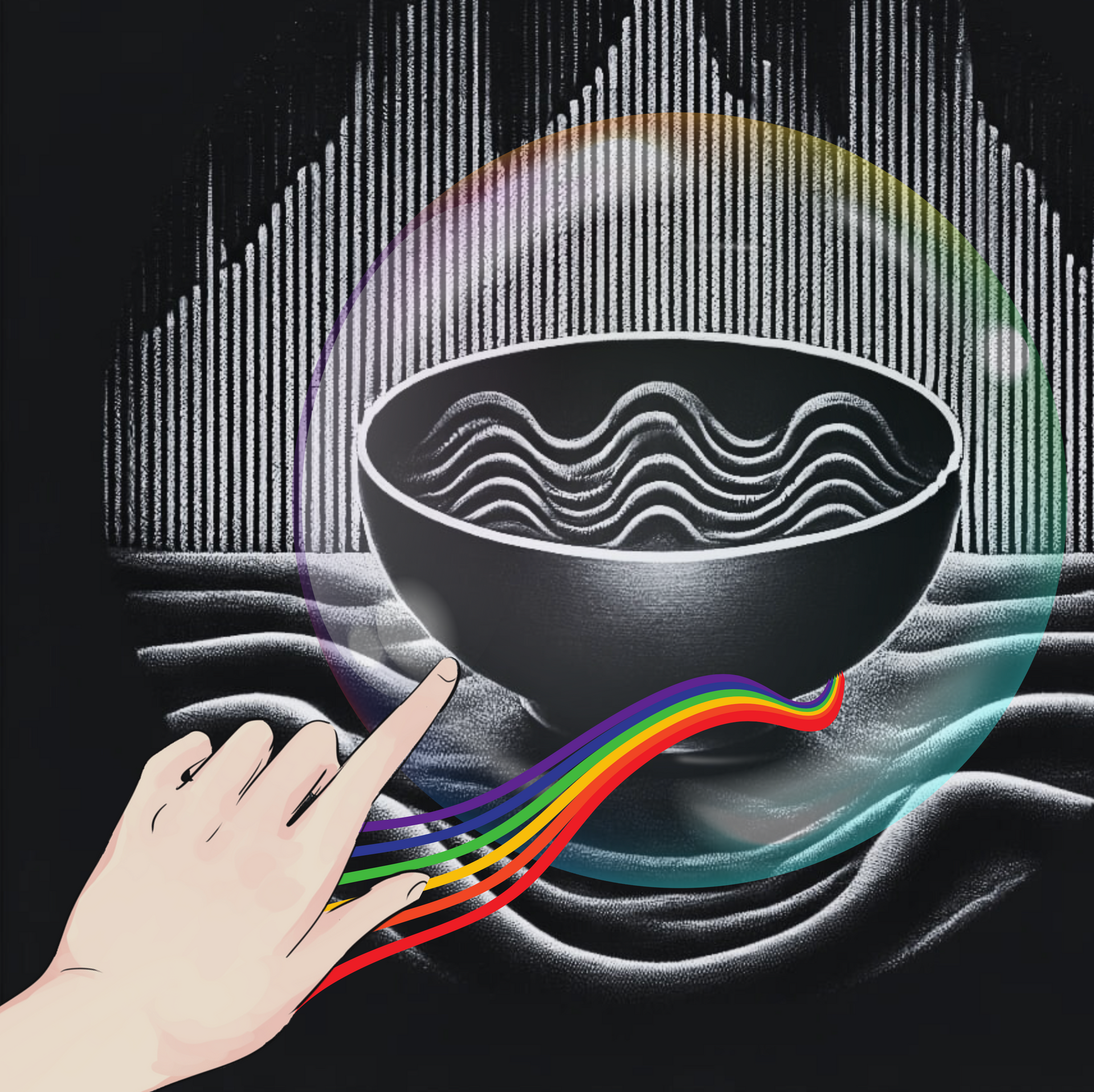The Atman of Sound: Rethinking Vibrational Geometry and Its Impact on Well-Being
The Atman and the Illusion of the Spherical Model in Sound
In Hindu and Tantric philosophy, the Atman refers to the inner self, the essence of consciousness, and the fundamental reality that transcends individual perception. It is often described as a bubble of existence, giving the illusion of separation while being part of a greater whole.
Similarly, in physics and acoustics, we assume that sound expands like a perfect sphere, but this is an illusion of scale and perception. Sound is not a static form, it is an interaction, a vibration that shapes space dynamically. This shift in understanding has major implications for sound therapy, especially in practices involving Tibetan singing bowls and digital sound technologies. If sound is not simply an expanding sphere but a fluid vibrational field, how should we rethink its application in wellness and sound technologies?

Sound, Tantra, and the Non-Existence of the Sphere
In Tantra, reality is not a single fixed point, but a flow of interactions between complementary forces. From this indivisible source emerges duality impersonated by Shiva & Shakti, the masculine & feminine principles, existence & consciousness, sound & silence, Yin & Yang. But even in this duality, Tantra immediately scales towards a trinitarian structure, for example, Brahma, Vishnu, & Shiva, or the three gunas (sattva, rajas, tamas) that define all action and perception.
This complexity mirrors the vibrational structure of sound itself. A pure tone does not exist in isolation, it emerges from interactions, harmonics, and layered frequencies. The sound of a singing bowl is not a single note but a system of relationships, one frequency interacting with another, forming something greater than the sum of its parts.
In both visual representation and sound propagation, the sphere has long been a dominant conceptual model. However, recent research challenges this assumption, suggesting that sound does not inherently expand in a perfect sphere but instead follows complex vibrational interactions and dynamic oscillations. This paper explores how the spherical assumption in acoustics impacts our understanding of sound therapy, digital sound design, and the physics of Tibetan singing bowls.
Understanding Sound as a Fundamental Experience
Ultimately, the real value of this discussion is not just theoretical, it’s about understanding how sound functions for us as a primal experience.
- Sound is one of the most direct ways we experience reality, shaping our emotions, physical state, and mental well-being.
- By refining our perception of how sound behaves, we gain a deeper connection to our sensory world.
- Rather than being constrained by technological limitations that impose artificial structures on sound, we can learn a different approach to sound as a holistic technology.
Modern research increasingly supports these ideas, showing that sound is not just about its physical properties but about how we engage with it. Sound therapy, meditation, and even the way we interact with music all rely on this fundamental relationship between vibration, perception, and resonance.
From a Tantric perspective, this aligns with the goal of understanding the mechanisms of life at all possible scales, whether the vast cosmic structures or the intimate, subtle experiences of the self. Tantra teaches that there is no separation between experience and understanding, between movement and stillness, between the observer and the observed. Sound is one of the few natural phenomena that embodies this principle. It is simultaneously internal and external, structured and fluid, real and intangible. It connects us to the very fabric of existence, reminding us that everything we perceive is, at its core, vibration.
The Physics of Sound: Beyond the Expanding Sphere
The Problem with the Sphere Model:
- Traditional models treat sound as spreading equally in all directions, but acoustic reality depends on its environment only.
- Even in an idealised setting, sound interacts with surfaces, air currents, and its own harmonics, disrupting the "pure sphere propagation" concept.
- Tibetan singing bowls do not radiate sound uniformly, they generate beating frequencies, harmonic resonances, and localised pressure zones.
If we move beyond the sphere model, what replaces it? Vibrational geometry suggests that sound is better understood as a network of oscillations rather than a uniform expanding shape.
- Beating frequencies (heard in singing bowls) create nodal points of interaction, forming a dynamic and evolving structure rather than a static shape.
- Sound in a metallic medium (such as a singing bowl) behaves more like an interference pattern, with frequencies reinforcing or canceling each other in a non-spherical fashion.
- In digital sound synthesis, waveforms are not spherical, but rather layers of harmonic structures that evolve over time.
This understanding extends to modern audio technologies. In contemporary sound engineering, we often assume that we "control" the direction of sound by positioning speakers or microphones in specific ways. However, sound itself does not respect these limitations, it propagates in all directions until an external factor (a surface, a filter, or human intervention) alters it.
- Speakers are directional, but inside the system, sound waves interact in all directions.
- Microphones pick up frequencies differently depending on their design, but they do not modify the fundamental multi-directionality of sound propagation.
- When we engineer sound environments, we are forcing a structure onto something that is naturally unstructured and vibrational.
This supports the idea that sound, rather than being an expanding sphere, should be thought of as an interweaving of frequencies interacting with their surroundings.
Observations and Final Reflections
Through our research, we have observed that sound exhibits both a rotational and expansive behaviour governed by harmonic ratios. This is not surprising, given that we are dealing with both therapeutic instruments and musical structures, both of which rely on harmonic balance and resonance as their fundamental principles. Furthermore, we note that the harmonic structure of sound directly corresponds to the harmonic structure of colours. This suggests that there is a way to scale sound beyond conventional frequency measurements such as Hertz (Hz) and Decibels (dB). Such an approach could allow for a deeper institutionalisation of sound healing, providing it with rational and even mathematical explanations that extend beyond subjective experience.
This perspective shifts the study of sound away from being centred on the human as the subject of experience and instead focuses on sound itself as a living entity. If sound has its own properties, behaviours, and laws, then it can be understood universally, not through subjective interpretation, but through the reality of its structure and how it manifests in our perception. Sound, therefore, should be studied not simply through its effect on humans, but through its own intrinsic structure, which is defined by more than two elements. As explored in previous research on the limitations of the Hz system, frequency alone does not define sound’s full behaviour, its harmonic relationships, spatial interactions, and vibrational geometry must also be considered.
This brings us back to Tantra, which has long recognised the necessity of understanding existence through a relational model rather than an isolated one. Shiva and Shakti, seen as an unbreakable duality, immediately give rise to a trinitarian structure (1-2-3) that reflects creation, motion, and manifestation. In sound, this triadic model is naturally present, it appears in harmonic overtones, vibrational interactions, and resonant structures.
By acknowledging that sound follows a vibrational trinity, we open the door to a new framework for understanding sound healing, music, and sound as a structured yet fluid force. This is not just an esoteric or philosophical conclusion, it is a practical, mathematical, and experiential truth that aligns science, spirituality, and direct sensory perception into a cohesive and comprehensive approach.
Thank you for taking the time to read, xx.












